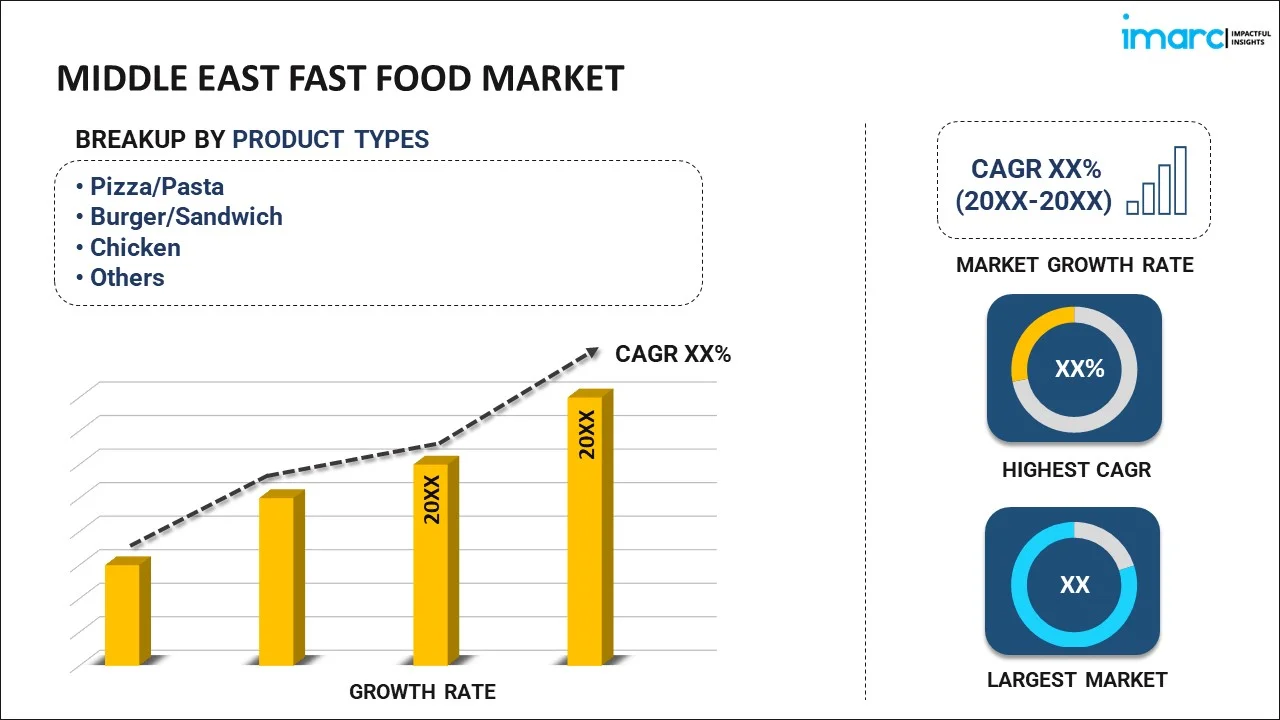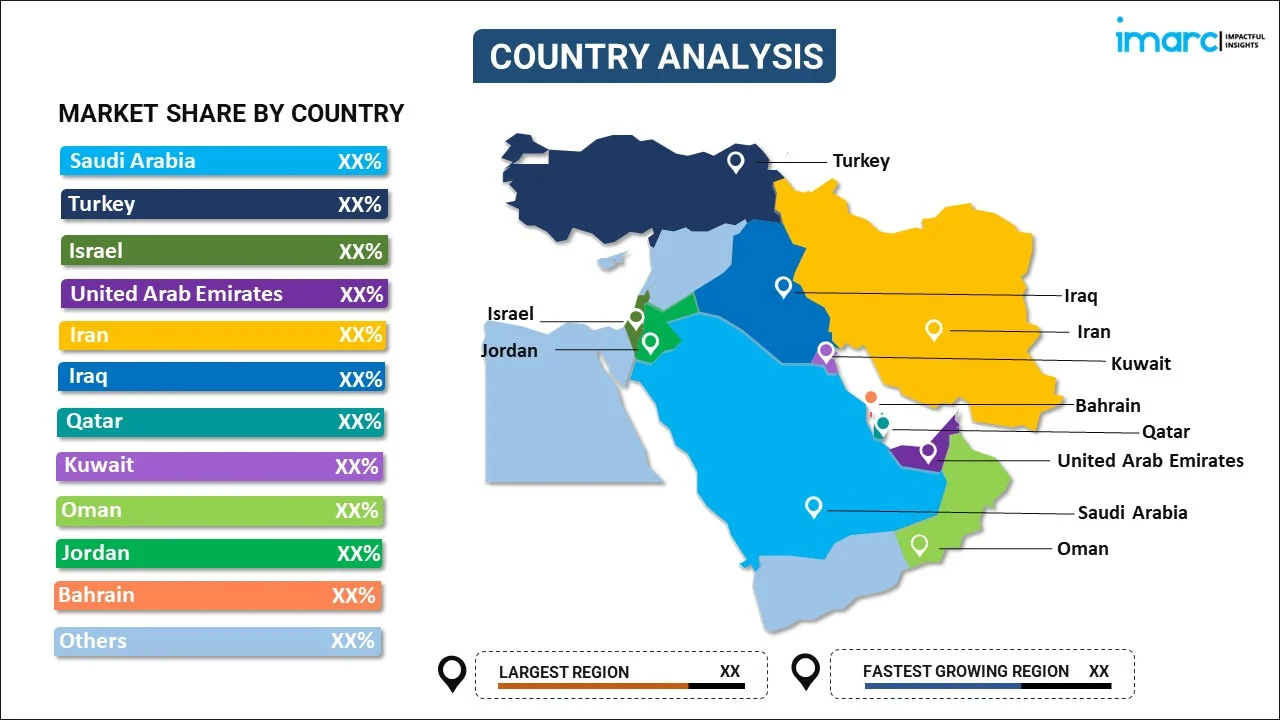
Middle East Fast Food Market Report by Product Type (Pizza/Pasta, Burger/Sandwich, Chicken, Asian/Latin American Food, Seafood, and Others), End User (Food-Service Restaurants, Quick Service Restaurants, Caterings, and Others), and Country 2025-2033
Market Overview:
Middle East fast food market size reached USD 51.4 Billion in 2024. Looking forward, IMARC Group expects the market to reach USD 84.0 Billion by 2033, exhibiting a growth rate (CAGR) of 5.2% during 2025-2033. Rapid urbanization, the changing dietary preferences, the appeal of international fast-food brands, availability of healthier menu options, and increased affordability are some of the factors supporting the market growth.
|
Report Attribute
|
Key Statistics
|
|---|---|
|
Base Year
|
2024
|
|
Forecast Years
|
2025-2033
|
|
Historical Years
|
2019-2024
|
|
Market Size in 2024
|
USD 51.4 Billion |
|
Market Forecast in 2033
|
USD 84.0 Billion |
| Market Growth Rate 2025-2033 | 5.2% |
Fast food is a ubiquitous and convenient culinary category characterized by quick service, easily prepared meals, and often, indulgent flavors. It includes items that are easy to prepare, such as hamburgers, fried chicken, pizza, tacos, and sandwiches. One of its primary advantages is its convenience. It caters to individuals with busy schedules or those looking for a quick and easy meal option. Fast food is typically served in packaging that is easy to handle and dispose of, facilitating on-the-go consumption. Moreover, fast food establishments are known for their efficiency in serving food to customers, typically with a focus on speed and convenience. These establishments are often located in easily accessible areas, and many offer drive-through services.
Middle East Fast Food Market Trends:
The Middle East fast food market is influenced by several key drivers, such as rapid urbanization, which has led to a growing demand for convenient and quick dining options. In line with this, the Middle East's thriving tourism industry has also played a significant role, attracting visitors who seek familiar international fast food brands, which is boosting the market growth. Moreover, the availability of diverse cuisines and flavors within the fast food segment has catered to the region's diverse consumer preferences, which is fueling the market growth. Furthermore, the expansion of delivery services and digital platforms has made it easier for consumers to access their favorite fast food options, which is accelerating the market growth. Another key factor is the surging health consciousness among consumers, which has compelled fast food chains to introduce healthier menu items, further stimulating the market growth. The Middle East's cultural openness to dining out and socializing has contributed to the popularity of fast food as a convenient choice for social gatherings, which is bolstering the market growth. Apart from this, the robust economic growth has increased disposable incomes, making dining at fast food restaurants more affordable for a broader segment of the population, which is facilitating the market growth in the region. Other factors, including rising expenditure capacities of consumers, and introduction of healthier options, catering to dietary restrictions, are supporting the market growth.
Middle East Fast Food Market Segmentation:
IMARC Group provides an analysis of the key trends in each segment of the market, along with forecasts at the regional and country levels for 2025-2033. Our report has categorized the market based on product type and end user.
Product Type Insights:

- Pizza/Pasta
- Burger/Sandwich
- Chicken
- Asian/Latin American Food
- Seafood
- Others
The report has provided a detailed breakup and analysis of the market based on the product type. This includes pizza/pasta, burger/sandwich, chicken, asian/latin american food, seafood, and others.
End User Insights:
- Food-Service Restaurants
- Quick Service Restaurants
- Caterings
- Others
A detailed breakup and analysis of the market based on the end user have also been provided in the report. This includes food-service restaurants, quick service restaurants, caterings, and others.
Country Insights:

- Saudi Arabia
- Turkey
- Israel
- United Arab Emirates
- Iran
- Iraq
- Qatar
- Kuwait
- Oman
- Jordan
- Bahrain
- Others
The report has also provided a comprehensive analysis of all the major regional markets, which include Saudi Arabia, Turkey, Israel, United Arab Emirates, Iran, Iraq, Qatar, Kuwait, Oman, Jordan, Bahrain, and Others.
Competitive Landscape:
The market research report has also provided a comprehensive analysis of the competitive landscape in the market. Competitive analysis such as market structure, key player positioning, top winning strategies, competitive dashboard, and company evaluation quadrant has been covered in the report. Also, detailed profiles of all major companies have been provided.
Middle East Fast Food Market Report Coverage:
| Report Features | Details |
|---|---|
| Base Year of the Analysis | 2024 |
| Historical Period | 2019-2024 |
| Forecast Period | 2025-2033 |
| Units | Billion USD |
| Scope of the Report | Exploration of Historical and Forecast Trends, Industry Catalysts and Challenges, Segment-Wise Historical and Predictive Market Assessment:
|
| Product Types Covered | Pizza/Pasta, Burger/Sandwich, Chicken, Asian/Latin American Food, Seafood, Others |
| End Users Covered | Food-Service Restaurants, Quick Service Restaurants, Caterings, Others |
| Countries Covered | Saudi Arabia, Turkey, Israel, United Arab Emirates, Iran, Iraq, Qatar, Kuwait, Oman, Jordan, Bahrain, Others |
| Customization Scope | 10% Free Customization |
| Post-Sale Analyst Support | 10-12 Weeks |
| Delivery Format | PDF and Excel through Email (We can also provide the editable version of the report in PPT/Word format on special request) |
Key Questions Answered in This Report:
- How has the Middle East fast food market performed so far and how will it perform in the coming years?
- What has been the impact of COVID-19 on the Middle East fast food market?
- What is the breakup of the Middle East fast food market on the basis of product type?
- What is the breakup of the Middle East fast food market on the basis of end user?
- What are the various stages in the value chain of the Middle East fast food market?
- What are the key driving factors and challenges in the Middle East fast food?
- What is the structure of the Middle East fast food market and who are the key players?
- What is the degree of competition in the Middle East fast food market?
Key Benefits for Stakeholders:
- IMARC’s industry report offers a comprehensive quantitative analysis of various market segments, historical and current market trends, market forecasts, and dynamics of the Middle East fast food market from 2019-2033.
- The research report provides the latest information on the market drivers, challenges, and opportunities in the Middle East fast food market.
- Porter's five forces analysis assist stakeholders in assessing the impact of new entrants, competitive rivalry, supplier power, buyer power, and the threat of substitution. It helps stakeholders to analyze the level of competition within the Middle East fast food industry and its attractiveness.
- Competitive landscape allows stakeholders to understand their competitive environment and provides an insight into the current positions of key players in the market.
Need more help?
- Speak to our experienced analysts for insights on the current market scenarios.
- Include additional segments and countries to customize the report as per your requirement.
- Gain an unparalleled competitive advantage in your domain by understanding how to utilize the report and positively impacting your operations and revenue.
- For further assistance, please connect with our analysts.
 Inquire Before Buying
Inquire Before Buying
 Speak to an Analyst
Speak to an Analyst
 Request Brochure
Request Brochure
 Request Customization
Request Customization




.webp)




.webp)












